P.V.Dobrovolsky, S.G.Garvalinsky. Materials technology cathedra, JSC "StomaDent", Moscow
"Maestro Stomatology" magazine, ¹ 4 (36), 2009
Materials for prevention of dental diseases play an important role in the production program of JSC "StomaDent". It is not by occasion, as in the world dental practice a big emphasis is made not only on therapy, but also on prevention. According to well known medical saying, "it is easier to prevent illness, than to cure it". As the practice shows, it is not only easier, but also more efficient economically for the patient, the doctor and the state in general.
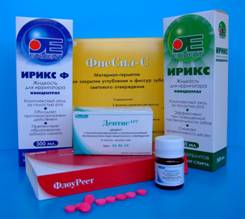 Preventive group of dental materials of JSC "StomaDent" includes the following:
Preventive group of dental materials of JSC "StomaDent" includes the following:
- fluorine-containing varnish («ProfiLac»);
- tablets for the diagnosis of plaque («Dinal»);
- sealants («FisSeal», «FisSeal-S»);
- glass ionomers («Dentis», «Dentis Art»);
- flowable composite («FlowRest»);
- liquids for irrigator («Irix», «Irix F»)
«ProfiLac» is designed for use in professional preventive practice. As anti-caries defense, teeth treatment by varnish with fluoride content has become a very widely used measure of local preventive practice. Such popularity is explained by the following factors:
- application of fluorine-containing varnish is easy to handle;
- all necessary instruments are cheap and simple (disposable brushes or applicators);
- varnish application can be combined with other preventive and therapeutic procedures.
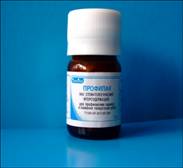 The varnish is made on the basis of national cedar balsam following a special technology allowing to keep active component – fluorine, in the state of dispersion, preventing precipitation. This gives the opportunity to use the material during guaranteed time with high effectiveness, unlike existing analogues, where fluorine precipitates. One should note that the use of varnishes with precipitated fluorine is contraindicative, because near vial bottom fluorine content is very high, and if it is used, one cannot exclude patient’s intoxication by high concentration of fluorine.
The varnish is made on the basis of national cedar balsam following a special technology allowing to keep active component – fluorine, in the state of dispersion, preventing precipitation. This gives the opportunity to use the material during guaranteed time with high effectiveness, unlike existing analogues, where fluorine precipitates. One should note that the use of varnishes with precipitated fluorine is contraindicative, because near vial bottom fluorine content is very high, and if it is used, one cannot exclude patient’s intoxication by high concentration of fluorine.
Biological components of «ProfiLac», produced by JSC «StomaDent», have a positive influence on reparative processes of periodontal tissues, have anti-inflammatory action and play the role of a kind of periodontal bandage, which is especially needed after professional oral hygiene. This also decreases after-operation sensitivity.
Important factors, common for fluorine-containing varnishes, are: transformation of hydroxyl-apatite in fluorine-apatite, and formation of calcium fluoride in the exterior tooth layer. After application of fluorine-containing varnish the tooth surface is protected by acid-proof layer of calcium fluoride.
Clinical tests of fluorine-containing varnishes use have shown their high effectiveness against proximal caries; in general they should start to be applied immediately after the appearance of second teeth as have no contraindication for use.
The use of «ProfiLac» is also prescribed:
- at dryness of the mouth (every 3 months);
- for prevention of caries of the tooth root (2-3 times a year);
- for treatment of increased teeth sensitivity (the course of 1-3 procedures during 7-10 days);
- for low-calcium teeth (4-8 times a year).
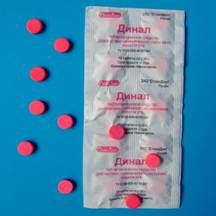 Important role in any prevention program plays the agent for teeth plaque diagnosis. JSC «StomaDent» produces the only such agent certified in Russia – «Dinal». These are tablets for the diagnosis of oral cavity state, which are also used for teaching hygienic teeth cleaning. The tablet’s composition includes iodeozin dye, which colors soft plaque in red, filler and sugar substitute.
Important role in any prevention program plays the agent for teeth plaque diagnosis. JSC «StomaDent» produces the only such agent certified in Russia – «Dinal». These are tablets for the diagnosis of oral cavity state, which are also used for teaching hygienic teeth cleaning. The tablet’s composition includes iodeozin dye, which colors soft plaque in red, filler and sugar substitute.
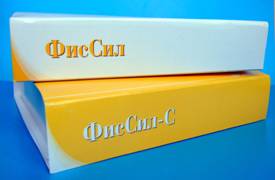 Next item in the preventive materials list of the Company are sealants - materials used for sealing pits and fissures of teeth, which have been named «FisSeal» and «FisSeal-S».
Next item in the preventive materials list of the Company are sealants - materials used for sealing pits and fissures of teeth, which have been named «FisSeal» and «FisSeal-S».
Composition, chemical formula and physical and mechanical qualities of these dental materials allow attributing them to classical sealants of insulating type. There is a big future in Russia for the use of sealants. Multiple clinical tests of foreign and national researchers show that the use of these dental materials is free of risk for health of children and adults, and at the same time is highly effective, which is reflected in reduced fissures caries.
The necessity to use sealants is determined by high spread of fissures caries. It is established that permanent molar teeth are first hit by caries when they only start to erupt; and within 1 year thereafter caries intensively progresses. Local fluorine-containing preventive means are effective mainly for the frontal teeth as well as for smooth aproximal surface of all types of teeth.
Fissure sealing, as a method of caries prevention, has become widely spread only in the latest 20-30 years, thanks to the development and use of principally new dental materials. The use of sealants is part of any complex preventive program, which would include endogenous use of fluorine-containing remedies, rational oral hygiene, balanced nourishment and regular inspection by dentist.
The essence of the method consists in sealing fissures and other anatomical formations of healthy teeth by sealants with the purpose of isolating them from caries-generating plaque.
Fissure sealing pursue two aims:
1. to create on the tooth surface a physical barrier against caries-generating factors;
2. when sealant has in its composition active fluorine components – making re-mineralizing influence on hard tooth tissues and oral cavity.
There are two methods of treating fissure caries:
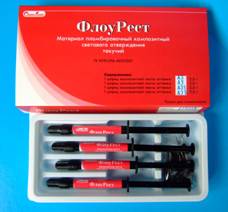 Non-invasive method presumes simple fissure sealing; invasive method presumes the use of various techniques of fissure preparation with further dilating and removal of adapted tissues followed by glass ionomer (of «Dentis» type) filling in combination with sealant «FisSeal», or by flowable composite filling such as «FlowRest».
Non-invasive method presumes simple fissure sealing; invasive method presumes the use of various techniques of fissure preparation with further dilating and removal of adapted tissues followed by glass ionomer (of «Dentis» type) filling in combination with sealant «FisSeal», or by flowable composite filling such as «FlowRest».
As a rule, age is not contraindication for this method. On the contrary, even if teeth after eruption stay intact for a long time, this does not mean that one should refuse from sealing, as habits may change, and the strength of caries-generating factors, both general and local, may change too.
There have been defined optimal periods of fissure sealing, which are connected to the periods of teeth eruption. In particular, permanent molars should be covered with sealant at 6-7 years age, premolars – at 9-10 years, second molars – at 9-11 years.
In Russia there is already a positive experience of using isolating type of sealants: both self-cure «FisSeal» and light-cure «FisSeal-S». The results of using sealants show that the materials were preserved on teeth surface 1 year after treatment in 95% of cases, and 3 years later – in 87% of cases. No indication of fissure and secondary caries on sealed teeth surface has been discovered. Similar experience connected with the use of sealants has been described in the works of numerous foreign researchers, who note full sealant retention on the surface of sealed teeth 1 year later in 90-95% of cases and 10 years later in 70-80% of cases.

Effectiveness of using sealants «FisSeal» and «FisSeal-S»
Based on the world practice of using sealants for teeth having low mineralized hard tissues, it is necessary to stress the importance of combined use of glass ionomers «Dentis», «Dentis Art» and sealant «FisSeal». Such a combination should be recommended for regions where caries intensity, according to World Health Organization’s criteria, is high or very high. A special technique of applying glass ionomer and sealant is required in this case.
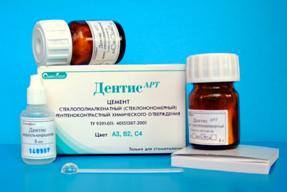 At present glass ionomers are also effectively used as means for fissure sealing. JSC «StomaDent» produces the following materials of this class: «Dentis» and «Dentis Art» which have the following characteristics:
At present glass ionomers are also effectively used as means for fissure sealing. JSC «StomaDent» produces the following materials of this class: «Dentis» and «Dentis Art» which have the following characteristics:
- chemical adhesion to hard tissues;
- lack of edge permeability;
- long anti-caries action.
This allows to classify them as bio-compatible materials.
When «Dentis» and «Dentis Art» cements are used as sealants the following aims are pursued:
- preservation of healthy teeth, as a result of regular fluorine injection in the tooth tissues and oppression of caries-generating microbes;
- activation of enamel-remineralization processes (even if there are centers of caries at the stage of white spot on the teeth enamel);
- the strongest retention of glass-ionomer sealants takes place in the deeper holes and fissures, where caries appears most often;
- in case of invasive treatment it is necessary to de-preparate with care the holes and fissures of chewing teeth surface, which are sealed.
«Dentis Art» cement participated in the demonstrative project of World Health Organization «The use of ART-technique in Russia» in Voronezh, where its high effectiveness was shown in practice.
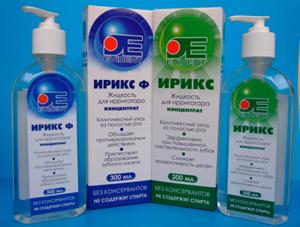 One of the latest preventive products of JSC «StomaDent» are irrigator liquids «Irix» and «Irix F».
One of the latest preventive products of JSC «StomaDent» are irrigator liquids «Irix» and «Irix F».
«Irix F» and «Irix», produced by JSC «Stomatology-Dentistry», have existed more than 1 year on the dental market of Russia and have well positioned themselves not only as irrigator liquids. The unique chemical composition allows to use these materials also as mouth rinse liquids for individual use in every-day hygienic procedures as well as in clinical practice of dentists for the carrying out of professional hygienic manipulations.
Myramistinum, forming part of the drugs, is antiseptic means, which has been used in medical practice for as long time. Being a cation detergent, it increases permeability of the cell capsule of micro-organisms and leads to their cytolysis. Myramistinum is active towards almost all micro-organisms (gram-positive and gram-negative, gram-nihilistic, spores-creative and spore-destructive, resistive to antibiotics). It makes action on mushrooms, vibrios, spirochetes, elementary.
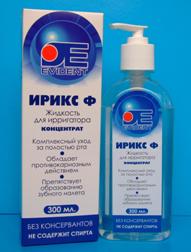 Hygienic means «Irix» and «Irix F» due to myramistinum activate local immune-defense, decrease inflammable reaction of tissues, stimulate reparative processes, diminish resistance of micro-organisms to antibiotics. The presence of fluorine compounds (0.05%) in «Irix F» provides anti-caries action and decreases teeth sensitivity. Research shows vivid and quick clinical effect, as compared to the use of chlorhexidine. This additive does not bring any bitter or unpleasant odor and taste, does not color teeth enamel, which is especially important after teeth bleaching, does not irritate mucous membrane of the mouth.
Hygienic means «Irix» and «Irix F» due to myramistinum activate local immune-defense, decrease inflammable reaction of tissues, stimulate reparative processes, diminish resistance of micro-organisms to antibiotics. The presence of fluorine compounds (0.05%) in «Irix F» provides anti-caries action and decreases teeth sensitivity. Research shows vivid and quick clinical effect, as compared to the use of chlorhexidine. This additive does not bring any bitter or unpleasant odor and taste, does not color teeth enamel, which is especially important after teeth bleaching, does not irritate mucous membrane of the mouth.
Myramistinum has been used in face-and-jaw surgery over 10 years, which allows to recommend «Irix» for wide cure and preventive use: after implant installation, splinting, orthodontic fixed-construction treatment.
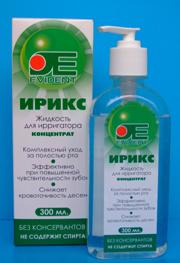 «Irix», which includes myramistinum (0.001%), kalium citrate (0.5%) and alumo-kalium alum, may be widely used in practical periodontology, as apart from the above mentioned actions, it also has hemostatic, astringent action and decreases teeth sensitivity by enamel hyperesthesia.
«Irix», which includes myramistinum (0.001%), kalium citrate (0.5%) and alumo-kalium alum, may be widely used in practical periodontology, as apart from the above mentioned actions, it also has hemostatic, astringent action and decreases teeth sensitivity by enamel hyperesthesia.
The drugs have well positioned themselves both as irrigator liquids and as mouth rinses. Patients noted that «Irix» and «Irix F» have convenient packaging, are transparent, have comfortable taste.
The team of JSC «StomaDent» understands the importance of preventive work in dentistry and continues to develop new dental materials. We hope that in the nearest future a wide spectrum of high-effective preventive materials will be produced, which will play a respectable role in dental practice.
Sources
1. Êóçüìèíà È.Í. Ïðîôèëàêòèêà ðàííèõ ôîðì êàðèåñà â ïåðèîä ïðîðåçûâàíèÿ ïîñòîÿííûõ çóáîâ ó äåòåé// Äèññ. êàíä. ìåä. íàóê / Ì., ÌÌÑÈ-1996.
2. Êóçüìèíà Ý.Ì. Ïðîôèëàêòèêà ñòîìàòîëîãè÷åñêèõ çàáîëåâàíèé ÌÇÐÔ// ÌÃÌÑÈ, Ìîñêâà. 2001.-184ñ.
3. Ëåóñ Ï.À. Êîììóíàëüíàÿ ñòîìàòîëîãèÿ//ÎÀÎ «Áðåñòñêàÿ òèïîãðàôèÿ», 2000.-284ñ.
4. Ìàêñèìîâñêèé Þ.Ì., Ñàãèíà Î.Â. Îñíîâû ïðîôèëàêòèêè ñòîìàòîëîãè÷åñêèõ çàáîëåâàíèé//Âëàäîñ-ïðåññ, Ìîñêâà. 2005.-202ñ.
5. Ïàõîìîâ Ã.Í., Ëåîíòüåâ Â.Ê. Àòðàâìàòè÷åñêîå âîññòàíîâèòåëüíîå ëå÷åíèå êàðèåñà çóáîâ// – Ìîñêâà, Æåíåâà. 2005.
6. Âèíîãðàäîâà Ò.Ô. Ëå÷åíèå è ðåñòàâðàöèÿ ìîëî÷íûõ çóáîâ//Ìîñêâà, Ìåäïðåññ-èíôîðì, 2006.





